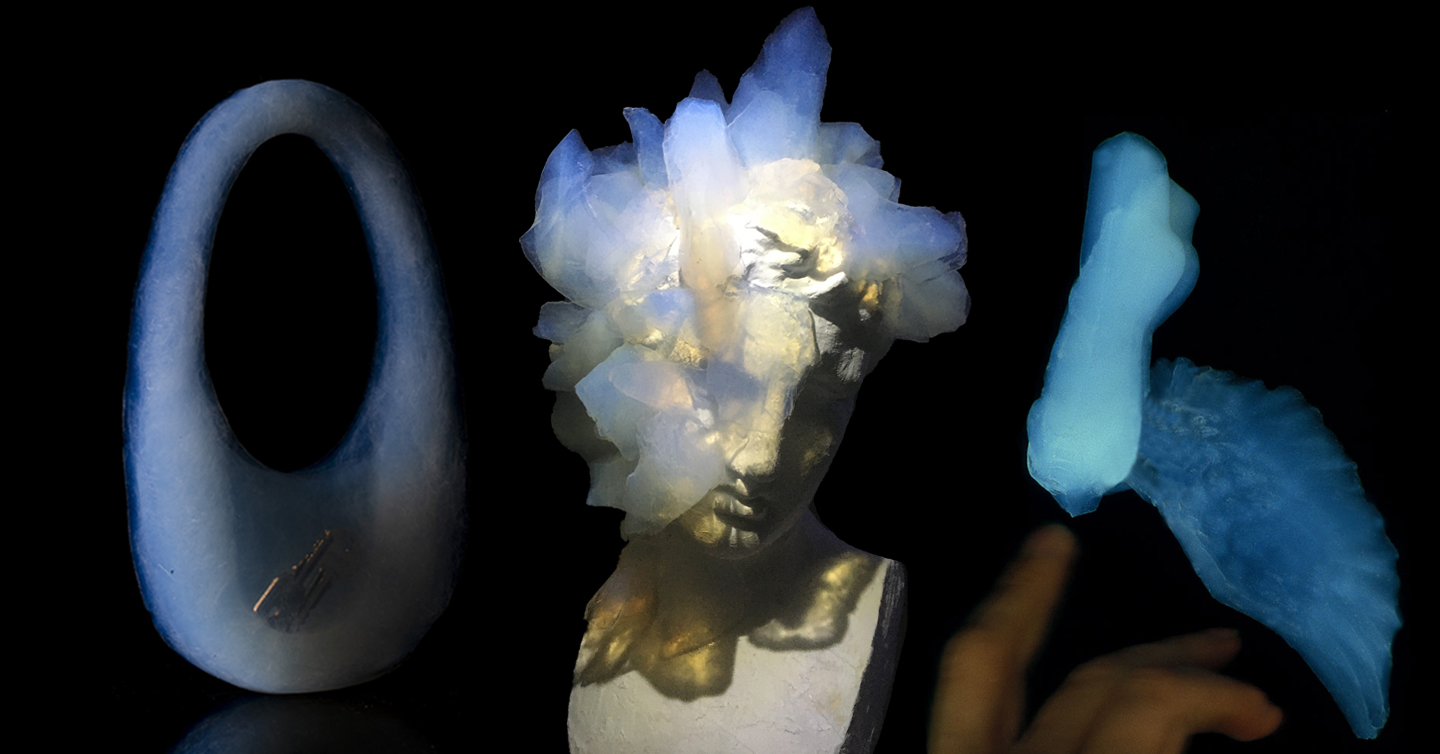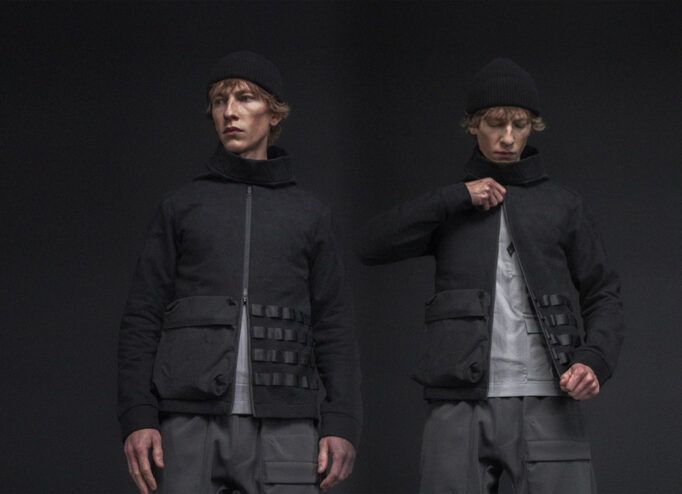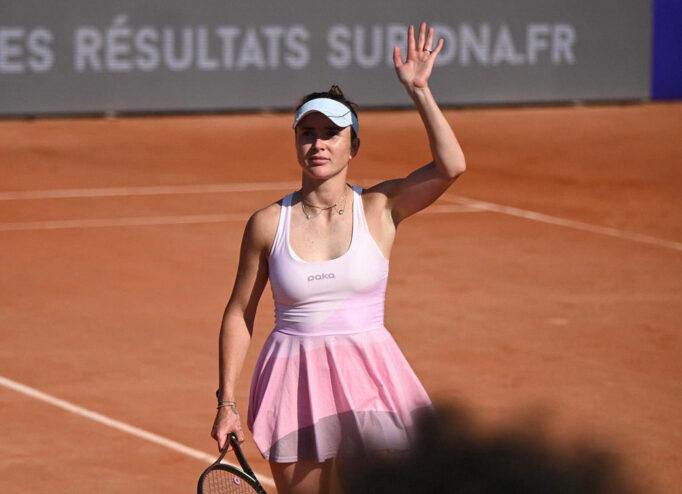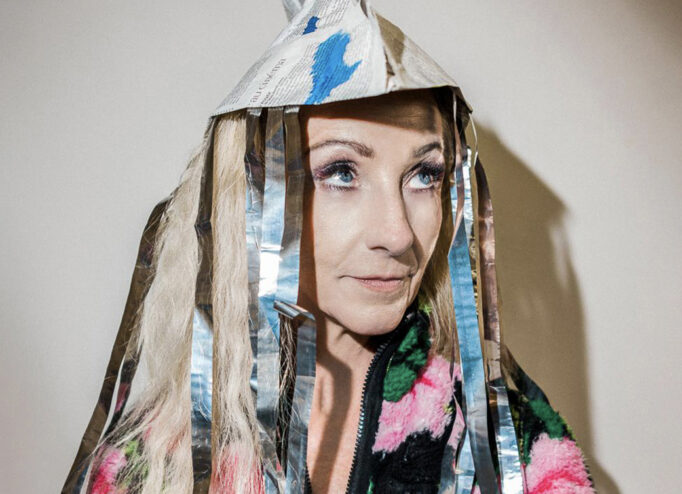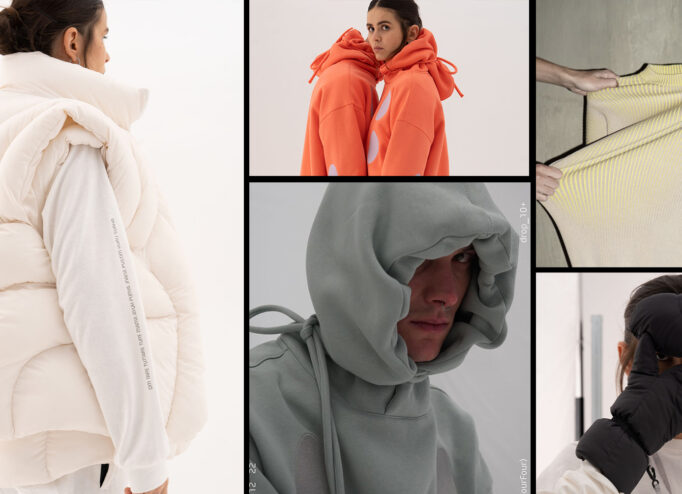Visual artist and researcher Dr. Ioannis Michaloudis is the only one in the world who knows how to create 3D objects from silica aerogel. He makes aerosculptures out of this NASA nanomaterial and also uses it in collaborations with brands. In 2020, he participated in the creation of a line of jewelry for Boucheron jewelry company, and in 2024 — in the creation of Air Swipe Bag for Coperni.
DTF Magazine asked Ioannis about the environmental message behind the Coperni bag, whether brands have really started to literally sell us air, and about his own creative practices and the outdated fashion system
“When you are young, you are crazy. And art is the same, it’s unlimited”
— In 1992 you started your artistic explorations with land art, within ten years you moved on to sky art and created your first silica aerogel sculpture. Why did you shift the focus of your materials from land to air?
— That’s a very good question. Once, while I was making “In the Circulation of Red Trees” — it’s a big project at the Sorbonne University—I took a photo. There was a red tree in the foreground, and in the background, there was a cloud looking like a hook. So [the shape of the cloud-like question] was the beginning of thinking about sky art, of thinking not about the land, but about the background.



Land art installation ‘In the Circulation of Red Trees’ was realized with the use of 250 square meters of red elastic fabric, 800 square meters of fishing net for the bandage of the trees, and 350 square meters of strap connecting the trees
And I went from Paris to Berlin, to speak about my future after my PhD with CHRISTO & JEANNE-CLAUDE because I like their work so much. When I went back to Paris by bus, I fell asleep and woke up during a stop at a gas station.
My mom did not have time to go to the hospital, and I was born on the bus, so inside the bus I have very good ideas. So I was looking at the sunset [in the window], and I understood that it was missing a cube-shaped cloud. So I started thinking about the cube-shaped cloud and making drawings, and later I applied for grants to realize it. I applied for a Fulbright Greek Artist Award and also to Massachusetts Institute of Technology, because the professor and artist Otto Piene, the founder of the Sky Art movement, worked there. So I found him in an art history reference book and contacted him by email. We started email communication in 2000, and a year later I received confirmation of the Fulbright program [for Greek artists]. So that was the beginning of shifting from Land art to Sky Art.
In 2002, I made a presentation of the cubic cloud at the last Sky Art Conference, which took place in Delphi and Ikaria island.
— Your first sculpture ‘Icare, I care…’ is related to Greek mythology. Is it a kind of tribute to your Greek roots or did you use it because Icarus is a famous symbol all over the world that represents the courage of the idea of flying to the sun but still being defeated by the forces of nature?
— It is a symbol of the sky, air, and youth. When you are young, you are crazy. And art is the same, it’s unlimited. Daedalus is the architect and Icarus’ dad, who made the wings, so he is the science, and Icarus is the art. The work about Icarus is not only symbolic, metaphorical, and allegorical, but also has a direct relation to Sky Art movement.
About the collaboration with Boucheron and Coperni
— You believe that art should collaborate with science to make something new. Are you broadcasting this idea by collaborating with jewelry and fashion brands?
— Yes. I’m continuing this idea. All my projects are similar and have always been a combination of art and science.
Silica aerogel is a very scientific and high-tech material, and although it was invented a long time ago, it is not used in many areas. And I was the first one to bring it in art and design — I created clouds in bottles, which can now be found on skyforsale.com.



Bottled cloud
The Boucheron jewelry company wanted to buy a cloud in a bottle. When I saw who the customer was, I contacted them, and they invited me to Paris to discuss the cooperation.The Boucheron jewelry company wanted to buy a cloud in a bottle. When I saw who the customer was, I contacted them, and they invited me to Paris to discuss the cooperation.
I told them that we could put gold, pearls, and any beautiful silver inside the silica aerogel. But they wanted to do it in a different way — to create from this material. I didn’t know if it would be wearable, but we started researching how to put the aerogel inside something that would protect the aerogel.
The aerogel is nanoporous, so it can absorb moisture from your skin, and undergo structural changes, so it needs protection. After some experimentation with borosilicate glass and quartz, we found that quartz has a more crystallized structure. So it is much more convenient for this type of jewelry.

The silica aerogel used for the Boucheron bracelet
With Boucheron, we had time. We started looking at the possibility of collaboration in 2018, with the support of my research foundation, NCSR Demokritos, in Athens. And then they gave me two years for research and development.
It was different with Coperni. Fashion works very fast. And they sent a request to my good friend and co-founder of the Aerogel company, Dr Stephen Steiner: “We are fans of aerogel; can we make the bag out of aerogel and present it on the first of March 2024?”. So they set a very concrete deadline. Steve immediately told me that no one but me knows the ways and secrets of production and the know-how to create 3D objects.


Aerosculpture made of silica aerogel
All the others, including NASA, don’t know how to make 3D objects from it. It’s very difficult, and this special process is my trade secret. So on November 21, Steve gave me the go-ahead to start, and 95 days later we presented the result in Paris.
“The current fashion system is incorrect, fast fashion works against humanity”
— The Coperni bag has spawned many jokes about how brands are now literally selling us air. How would you comment on that?
— It’s better to sell air that is air of the future than to sell air and deceive people. So I believe in the air of the future. And [this bag] is 99% air of the future. It’s also 99% nothing, you don’t cast or sculpt anything. You just put this silica aerogel in a mold and create any 3D object.



The Coperni bag made of silica aerogel
But this is not so much a ‘sale of air’ as a message about the quality of our air — a kind of SOS signal, a Save Our Sky distress signal. So for me, this is a metaphor about our air and the quality of our sky.
You know, the sky is our planet’s ‘cloth’, it is the last layer, the blue haze around us. It is also the protection of the planet. So we have to be careful not only with it, but with the entire food chain from the very beginning, including the way we use meat, for example, or animals in general. All of this has to change. Otherwise, we will destroy the planet’s garment and ourselves.
— And do you think it affects or changes the current model of consumerism, and in what way?
— At this moment, no. But as soon as the public realizes that this is a metaphor for the sky, they may take a different approach to their everyday actions and the way they behave towards others. So fashion will become more green because the current fashion system is incorrect, fast fashion works against humanity.
— And do you also put the environmental idea into such items as a Coperni bag?
— This idea exists independently. If you say I create “aerosculptures” you immediately imagine the environment. That is, you already have a connection with it. If you go outside for a walk, the environment around you will be blue because it’s the sky.
In 2021, I presented the (C)osmosis project in Hainan, China where I placed the fragments of the sky around the head of a Greek classic sculpture — Ephebe of Marathon. It was amazing.

Ephebe of Marathon sculpture with aerogel around the head
You can steal the statues from Greece, but you cannot steal the surrounding sky. For example, the great female statue of a Caryatid was stolen by Lord Egin from the Parthenon. So because her hands are lost for ever, I proposed a restoration project in Journal of Sol-Gel Science and Technology, where her hands will be replaced by the surrounding sky. This paper had been already published with the title (M)other tongue.
The environment has a huge impact, even the simplest microorganisms or animals and humans, the first thing they see above them is the sky. Without the sky, we have no life. And this return of the sky to our thinking, to our hearts, and the return of love for it, is part of my work.
— You suggest using silica aerogel to restore cultural heritage objects as an alternative to the classic method of restoration using plaster. Why is this material better than classical plaster of Paris techniques? And what is the value of this idea?
— Silica aerogel is not a better restoration material, it is more beautiful; and because of its translucent and exotic nature it is suggesting (and not imposing) the missing part of the sculpture. For me as a visual artist it has also conceptual value: you are taking the environment, the sky around a sculpture, you are using the sky as a sculptural material and you restore the damaged sculpture in a poetic and meaningful way. Restoration materials nowdays they have not to be only materials they have to be messengers as the sculptures themselves.


The Coperni bag made of silica aerogel
— Silica aerogel is a sturdy material, but many commenters on social media are also concerned with the question: what can you put in this Coperni bag? What are your ideas?
— Because the volume of the alcogel was too big it was quite difficult to supercritical dry it. So, I needed an empty space to “divide” the thickness of the bag. And my design proposal was to divide the bag with a pocket. Coperni didn’t like this option, but I explained to them that otherwise we wouldn’t be able to dry such a large volume of aerogel. So you need to go slow. It’s like bread— it can look baked on the outside, but still be raw and fragile on the inside.
So that’s why we made a small pocket. So you can put in it an iPhone -of the old generations that I like, SE for example, or 4S. And also you can put your keys and some cash, for example, some coins.
— Have we reached our limit in terms of technology that can be used in fashion or art? Or have we not yet mastered even a small percentage?
— No, this is just the beginning. We already have AI, nanotechnology and nanoscience, and we’re going to see a lot of beautiful technological things. I hope that these technologies will be beautiful too.
Initially, it was not the technology that attracted me to silica aerogel, but its beauty. Artists seek beauty, and scientists seek truth. So beauty and truth is the dialogue between art and science. And sometimes I say that it’s probably one and the same thing — to look for beauty and truth, but from different perspectives.
